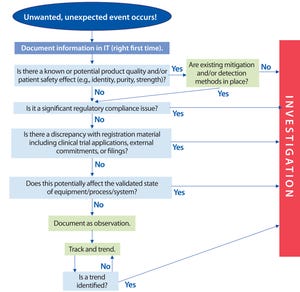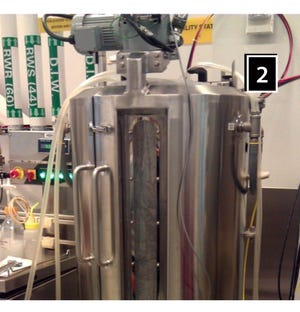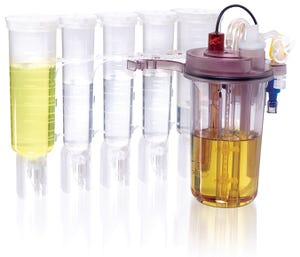BioProcess International
and the BPI Conference are a bit like twins in that they were born together, but one arrived just ahead of the other. The magazine evolved from a close relationship between its founders and the staff of “IBC Life Sciences” just after the turn of the century. And as we got the publication going back in 2002–2003, we realized that four separate IBC meetings could come together as one under its banner and now-familiar logo. We’ve been colleagues all along — but looking ahead to 2018, you’ll see a much closer partnership emerge.
Over the past dozen years or so, in developments that would be familiar to anyone in biotechnology, various iterations of company name and corporate structure (along with staff members) have come and gone. And we all faced the task of maintaining our collaborative legacy amid those internal changes. Whereas three of BPI’s four founders remain today (as do the name and basic mission of the publication), IBC has become “Knect365 Life Sciences” with a relatively...
“Smaller Is Better” Chemical Bioproduction
Ramon Gonzalez, professor of chemical and biomolecular engineering at Rice University and director of its Advanced Biomanufacturing Initiative (iBIO), believes that “waste” methane represents an opportunity for biomanufacturing that should not be missed. Instead of getting burned off, methane could and should generate profits. With advancements in biomanufacturing, wild-type or genetically modified bacteria can turn carbon-rich methane into valuable chemicals — producing them at smaller scales in more environmentally friendly processes than those of classical chemical manufacturing.
ADOBE STOCK (HTTP://STOCK.ADOBE.COM)
Gonzalez specializes in genetically engineering bacteria for biotechnology. In a January 2017
Science
paper, he and his Rice colleagues — research scientist James Clomburg and graduate student Anna Crumbley — show that advances in metabolic engineering, genomics, and industrial process design have brought industrial biomanufacturing closer than e...
Figure 1: Overview of proposed two-tier process
All biopharmaceutical companies espouse a belief in scientific, risk-based approaches. However, with respect to deviation management systems (DMSs), the industry is falling short of that promise. By and large, companies still use a small-molecule pharmaceutical compliance model that dates back to the 1980s, based on the strategy that all deviations are created equal and require 30-day closure. Most bioprocessors still hold to a default 30-day rule, even though there is no specific regulatory requirement for that time frame. Major or critical investigations often take 50–60 days or longer, and simpler events can be closed much faster. The 30-day rule is not risk-based, and it can drive the wrong behaviors by promoting a check-the-box mindset and creating pressure to close an investigation without finding the true systemic root cause.
Some attempts have been made to improve on the above model, although most companies have tweaked their systems using the same f...

 +3
+3ADOBE STOCK (HTTP://STOCK.ADOBE.COM)
Global perspectives of China as a major biopharmaceutical supplier have changed over the past decade. In 2008, BioPlan Associates completed its first analysis and directory of the top 60 biopharmaceutical facilities in China (
1
). Based on findings from our study titled
Advances in Biopharmaceutical Technology in China
(
2
), we found that China clearly held the image of a low quality manufacturer of biogeneric products almost exclusively for its domestic market. Further, concerns over intellectual property protection, contracting problems, and management issues all created an impermeable barrier to biologics manufacturing in China.
Today, due in large part to substantial investments in bioprocessing quality management, hiring and training of staff, and attraction of talented industry staff from abroad, China’s bioprocessing capabilities have grown quickly and substantively from that low baseline presented in our earlier study. Our report,
Top 60 Biopharmaceutical ...

 +1
+1www.graphicstock.com
In the current global regulatory environment, management and implementation of postapproval CMC changes often can be unpredictable and inefficient. Timelines for change approval can vary from months to years, depending on regional regulatory procedures. Therefore, the challenge in postapproval lifecycle management is to maintain a constant supply of high-quality product while supporting innovation and continual improvement. This was the premise of the CASSS Chemistry, Manufacturing, and Controls (CMC) Strategy Forum held in Gaithersburg, MD, on 20–21 July 2016. The forum explored pathways for operational flexibility in the postapproval phase of the biopharmaceutical product lifecycle and specifically focused on the following topics:
According to the concept paper for the proposed ICH Q12 guideline (Technical and Regulatory Considerations for Pharmaceutical Product Lifecycle Management), ICH Q12 intends to improve the efficiency of regulatory evaluation, both in review and inspection o...

 +5
+5Use of disposable bioreactors in the biopharmaceutical industry has increased gradually over the past several years in pilot, clinical, and production scale facilities (
1
–
4
). Reduced time to market in today’s drug industry has created a need for cost-effective development and production strategies as well as manufacturing flexibility. When compared with traditional stainless steel equipment, disposable bioreactor and mixing systems have smaller space requirements, are portable, and come presterilized to eliminate the need for preuse sterilization procedures such as steam-in-place (SIP). Additionally, because their product-contacting surfaces are disposable, the need for clean-in-place (CIP) and associated validation is eliminated (
4
,
5
). Disposable systems also allow for faster turn-around times in between runs, reduce contamination risks, and ultimately increase flexibility for production facilities.
Meanwhile, improved process development and engineering strategies — including optimization of ex...

 +2
+2Figure 1: Anaphylaxic reaction (ADOBE STOCK HTTP://STOCK.ADOBE.COM)
Rapidly increasing use of monoclonal antibodies (MAbs) in the treatment of neoplastic, autoimmune, and inflammatory diseases has led to a dramatic increase in hypersensitivity reactions worldwide, complicating the use of MAbs as first-line therapies and limiting patient survival and quality of life (
1
). The origins of anaphylaxis are not well understood, though its mechanism is fairly straightforward (Figure 1). It is usually attributed to some undefined intrinsic property or properties of a biotherapeutic — despite the fact that biotherapeutic formulations are necessarily complex and include a host of functional excipients. Those help drug products meet the stringent challenges of shelf-life, stabilization, solubility, reconstitution following lyophilization, and the propensity of proteins to aggregate — especially at the high concentrations typically used to reduce MAb administration volume and time.
Approximately 70% of all MAb formu...
Photo 1: ambr 250 modular automated minibioreactor system
There has been a rapid rise in the number of positive clinical outputs from clinical studies based on gene and cell therapies. This is in addition to the licensing of products such as GlaxoSmithKline’s Strimvelis ex-vivo stem-cell therapy for treatment of severe combined immunodeficiency caused by adenosine deaminase deficiency (ADA-SCID) in 2016 (
1
) — has led to an increase in demand for therapeutic vector manufacturing capabilities. Viral vectors are being used for an increasing range of conditions, including monogenetic conditions. Recently cell engineering has led to T cells that express chimeric antigen receptors (CAR-T) as well as gene-editing based therapies.
Figure 1: Overview of plasmid DNA applications in the manufacture of gene and cell therapy vectors
Those advancements are reflected in predictions that the total gene-therapy market will grow to US$9.1–12.6 billion by 2025 (
2
) and the associated manufacturing market to $1.335 billio...
In her “Ask the Expert” webcast on 21 June 2017, Aziza Manceur of the National Research Council Canada (NRC Canada) discussed the benefits of using insulin in bioprocessing.
Manceur’s Presentation
Canada’s NRC has research facilities across Canada covering disciplines such as aerospace, energy, mining, and medical devices. The NRC serves both the government and the private sector, working with Canadian and international clients. Manceur is based in Montreal with the cell culture scale-up team (in the human health and therapeutic group). The team works on process robustness and looks for industrially relevant strategies for producing viral vectors, antibodies, and recombinant proteins using suspension cells in large-scale bioreactors.
In one project, Manceur’s group tested insulin as a booster for cell growth and influenza production. The hormone supports cell growth and is widely used in bioprocessing. Already approved by regulatory agencies, the recombinant form available from Novo Nordisk is not animal ...













